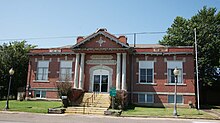Wagoner, Oklahoma
In the fall of 1895, the community formed a commission that circulated a petition requesting incorporation under the statutes of Arkansas.
[5] A privately funded courthouse was built in 1897, which housed a newly created U. S. Western District Court.
The Dawes Commission turned Indian Territory land from tribal to individual ownership by members of each tribe.
The individuals were allowed to sell their land to non-Indians, causing a real estate boom in farmland around the area.
The MKT had located a division headquarters in the city, which then had three railroad trunk lines and twenty passenger trains a day.
The oil boom farther west and later, the Great Depression, caused a further decline in the city's economy and population.
The city lay between two war-related Federal Government projects: Camp Gruber to the south and the Oklahoma Ordnance Works to the north.
Completion of the nearby Fort Gibson Lake in 1950 stimulated the economy and turned Wagoner into a sports and retirement center.
The McLellan-Kerr navigational channel made the agricultural area accessible by barges, stimulating farm-related businesses.
[5] According to the United States Census Bureau, the city has a total area of 7.0 square miles (18 km2), all land.
On Tuesday, April 21, 2015, The Tulsa World announced that its parent company BH Media, a division of Berkshire Hathaway, the Omaha-based investment holding company led by billionaire Warren Buffett had purchased several suburban newspapers, including the Wagoner Tribune.
[11][12] Wagoner is served by US-69, SH-51, and SH-16, and has easy access to the Muskogee Turnpike, also known as SH-351, providing a direct route to Tulsa.










